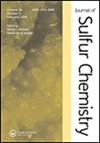硫浸渍和硫功能化活性炭暴露于Hg0蒸汽的DFT研究
IF 2.1
3区 化学
Q3 CHEMISTRY, MULTIDISCIPLINARY
引用次数: 0
摘要
为了去除诸如汞的有毒蒸汽排放物,有必要在了解其性质和与蒸汽相互作用的基础上选择合适的材料。由于汞对硫具有较高的亲和力,因此本研究探讨了硫浸渍活性炭对汞的吸附。采用离散傅里叶变换(DFT)模拟计算了硫在活性炭上浸渍并吸附Hg0蒸汽的过程。研究了扶手椅边、锯齿边和石墨烯表面活性炭对硫的吸附。研究了带羟基、羧酸等边缘官能团的活性炭对硫的吸附。进一步研究了边缘官能团为磺酸、亚磺酸、亚硫酸的活性炭对Hg0蒸气的吸附效果。在活性炭的边缘官能团中,羟基最有利于硫的吸附,随后是Hg0蒸气。这被量化为最短的键长,最强的结合能,和最大的电荷转移。在活性炭上的含硫官能团中,亚磺酸最有利于吸附Hg0蒸气。通过过渡态计算,提出了硫浸渍活性炭吸附Hg0的反应途径。本文章由计算机程序翻译,如有差异,请以英文原文为准。
DFT studies on exposure of sulfur impregnated and sulfur functionalized activated carbon to Hg0 vapors
For removal of poisonous vapor emissions such as mercury, it is necessary to select suitable materials based on an understanding of their properties and interactions with the vapor. As mercury has a high affinity towards sulfur, it’s adsorption using sulfur-impregnated activated carbon was explored in this study. The impregnation of sulfur on activated carbon followed by the adsorption of Hg0 vapors was computationally investigated using DFT simulations. Sulfur adsorption was investigated on activated carbon with armchair edge, zigzag edge, and graphene surface. Sulfur adsorption was investigated on activated carbon with edge functional groups such as hydroxyl and carboxylic acid. Activated carbon with edge functional groups such as sulfonic acid, sulfenic acid, and sulfinic acid was further investigated for the adsorption of Hg0 vapors. Among the edge functional groups on the activated carbon, the hydroxyl group was most favored for sulfur adsorption and, subsequently, Hg0 vapors. This was quantified in terms of shortest bond lengths, strongest binding energies, and maximum charge transfer. Among the sulfur-containing functional groups on activated carbon, sulfenic acid was the most favored for the adsorption of Hg0 vapors. Transition state calculations were carried out, and a reaction pathway was proposed for the adsorption of Hg0 on sulfur-impregnated activated carbon.
求助全文
通过发布文献求助,成功后即可免费获取论文全文。
去求助
来源期刊

Journal of Sulfur Chemistry
CHEMISTRY, MULTIDISCIPLINARY-
CiteScore
4.10
自引率
9.10%
发文量
38
审稿时长
6-12 weeks
期刊介绍:
The Journal of Sulfur Chemistry is an international journal for the dissemination of scientific results in the rapidly expanding realm of sulfur chemistry. The journal publishes high quality reviews, full papers and communications in the following areas: organic and inorganic chemistry, industrial chemistry, materials and polymer chemistry, biological chemistry and interdisciplinary studies directly related to sulfur science.
Papers outlining theoretical, physical, mechanistic or synthetic studies pertaining to sulfur chemistry are welcome. Hence the target audience is made up of academic and industrial chemists with peripheral or focused interests in sulfur chemistry. Manuscripts that truly define the aims of the journal include, but are not limited to, those that offer: a) innovative use of sulfur reagents; b) new synthetic approaches to sulfur-containing biomolecules, materials or organic and organometallic compounds; c) theoretical and physical studies that facilitate the understanding of sulfur structure, bonding or reactivity; d) catalytic, selective, synthetically useful or noteworthy transformations of sulfur containing molecules; e) industrial applications of sulfur chemistry; f) unique sulfur atom or molecule involvement in interfacial phenomena; g) descriptions of solid phase or combinatorial methods involving sulfur containing substrates. Submissions pertaining to related atoms such as selenium and tellurium are also welcome. Articles offering routine heterocycle formation through established reactions of sulfur containing substrates are outside the scope of the journal.
 求助内容:
求助内容: 应助结果提醒方式:
应助结果提醒方式:


